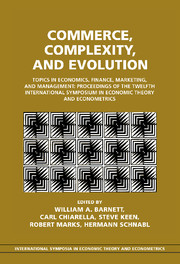 Commerce, Complexity, and Evolution
Commerce, Complexity, and Evolution Published online by Cambridge University Press: 05 December 2011
Present-day mainstream neoclassical economic theory is built on the perfect competition paradigm. It can be shown that, when the paradigm and its underlying assumptions are satisfied, an economy ends up in general equilibrium that represents the highest possible state of welfare. To reach this state, three assumptions must be satisfied. First, perfectly competitive markets must exist, including perfect information for all agents operating on these markets. Second, there must be two exogenous sets of fixed parameters, consumer preferences and production technology. Third, all agents must adopt utility maximization as their behavioral motive. Equilibrium is reached when all pairs of marginal costs and benefit ratios are equalized. At that point entropy is maximized and economic activity – agents making choices – must necessarily cease because no agent can further improve his or her position. At best, economic activity goes on in the reproductive mode, whereby agents eternally exchange the same mix of goods and services at the same prices. In the absence of external impulses, the economic system dies an entropy death.
From a systems theory point of view, the neoclassical perfect competition paradigm is incomplete because it has no entropy-decreasing mechanism and is not self-sustainable. In the case of economic systems, a competition-reducing force is required to keep it going. That is precisely the role of innovation. In terms of the neoclassical model, innovation can be introduced only through modification of exogenous behavioral parameters, consumer preferences, and production technology. In ordinary language, this is called inventions and the introduction of new consumer ideas.
To make innovation a regular feature of the economic model, these exogenous parameter modifications need to be endogenized in the system.
To save this book to your Kindle, first ensure [email protected] is added to your Approved Personal Document E-mail List under your Personal Document Settings on the Manage Your Content and Devices page of your Amazon account. Then enter the ‘name’ part of your Kindle email address below. Find out more about saving to your Kindle.
Note you can select to save to either the @free.kindle.com or @kindle.com variations. ‘@free.kindle.com’ emails are free but can only be saved to your device when it is connected to wi-fi. ‘@kindle.com’ emails can be delivered even when you are not connected to wi-fi, but note that service fees apply.
Find out more about the Kindle Personal Document Service.
To save content items to your account, please confirm that you agree to abide by our usage policies. If this is the first time you use this feature, you will be asked to authorise Cambridge Core to connect with your account. Find out more about saving content to Dropbox.
To save content items to your account, please confirm that you agree to abide by our usage policies. If this is the first time you use this feature, you will be asked to authorise Cambridge Core to connect with your account. Find out more about saving content to Google Drive.